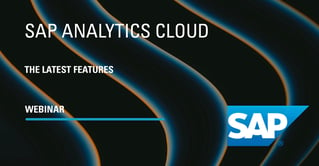Share this
7 reasons why you need support for SAC (Sap Analytics Cloud)
SAC (SAP Analytics Cloud) is an excellent tool that benefits your users greatly, both for the planning process and the BI insights. SAP sells it as a self-service tool, which is true from a front-end perspective. There is more to it than building reports though, a lot more. Even in the cloud, you still need support to get the most out of your SAC application. Discover the 7 reasons why.
1. Even cloud applications need support
Let’s start with a common misconception: “Cloud applications don’t need support.” It's true that technical topics such as updates of the software and platform are taken care of. However, the functional part can require just as much support as, for example, SAP BPC used to do.
Also, some technical maintenance is still needed, such as data maintenance. For example, setting up and maintaining data archiving is crucial to avoid performance issues.
2. The back-end and front-end need to align seamlessly
SAC is a powerful application. Getting all that power working for you requires a lot of combined back-end and front-end knowledge. For the back-end, SAC can connect to many different sources. Usually, this includes the SAP BW/HANA environment or maybe Datasphere, the new innovative cloud-based data warehousing solution from SAP.
Many business users can intuitively create a report or dashboard with a standardized data set. However, the underlying data set is more complex and most likely modeled from multiple sources. Modeling data from all these different sources requires a specific skill set. Often, we see that the modeling of data is underestimated. However, it is vital for the reliability of your reports.
3. SAC uses code for customization – do we need to say more?
Where SAP BPC was Excel-based, the web front-end in SAC uses JavaScript. SAC also has an Excel add-in, but it is mainly usable for reporting and is very limited for customization at this moment.
The web front-end in SAC makes creating "drag and drop" reports and dashboards very accessible. Creating a customized application for planning input is another story. Restricting user input and integrating data actions are examples where JavaScript code will be necessary. Most business users don't have this knowledge and are not interested in it. It still requires a DevOps team to code and design a good user experience in an application.
4. SAC provides Planning and BI in one tool
SAC has multiple purposes: it gives you BI and EPM functionalities in one tool. It is a huge benefit, but one that requires expertise in both. Our integrated Service Desk for EPM and BI gives your users one point of contact for all your questions. As users may not know where the origin of the issue lies, many of our clients find this very helpful. Users don’t have to worry about who to call for which issue but can simply contact one Service Desk.
Also, the data for SAC is often coming from various sources. Where the finance data often comes from ERP sources, BI data can have multiple sources, such as HR, marketing, and operational planning. Therefore, expertise of more than just the front-end is needed to establish the core of an issue.
5. SAC is still developing and growing
Quarterly updates are very nice as they bring new functionality and solve issues. The downside is that they can also potentially break already existing developments. Therefore, the upcoming updates need to be adequately tested.
Besides this, each quarter, new features solve specific issues faced in the past or provide new functionalities that might benefit the business. These new features also need to be tested and implemented (if it is a new function) or adjusted to the existing workaround, as it is now permanently fixed by the new functionality.
Most organizations don’t have the time or the expertise to dive into these new features. Our experts do and can highlight those features for you that will add value to your organization. At Swap Support, we call this ‘proactive support’.
6. Multiple processes involve many different stakeholders
The fact that you can use SAC for multiple business processes is great. However, all these business processes have specific stakeholders, which can be quite complex from a support perspective. Dealing with many stakeholders is often more efficient by having one central point of contact to orchestrate this.
7. Security and performance require the right architecture
One of the benefits of SAC is that it’s effortless to create a new data model. But building a model requires knowledge, and creating a great model requires even more expertise. The function itself is easy, but the architecture is something you need to focus on – and you need experience to answer questions such as ‘How efficient is the data model?’ and ‘What is the impact on performance?’.
Besides performance, you need to consider who can consume the data in your model and how you will protect this with security. Security is usually overlooked and, unfortunately, complex to implement efficiently.
Gain time to focus on your core role
Outsourcing support for your SAC application lets you focus on your core activities. Not having to worry about the software gives you the freedom to add more value to your organization. You and your users can give full attention to providing meaningful, reliable insights and reports.
Watch our webinar
Discover the ins and outs of the Q4 2023 and Q1 2024 releases and get even more out of your SAC application.
Share this
- March 2025 (2)
- February 2025 (2)
- December 2024 (1)
- July 2024 (3)
- April 2024 (2)
- March 2024 (1)
- February 2024 (1)
- January 2024 (3)
- December 2023 (1)
- June 2023 (1)
- April 2023 (1)
- March 2023 (1)
- December 2022 (1)
- September 2022 (1)
- August 2022 (2)
- March 2022 (1)
- February 2022 (1)
- December 2021 (1)
- May 2021 (15)
- April 2021 (24)

